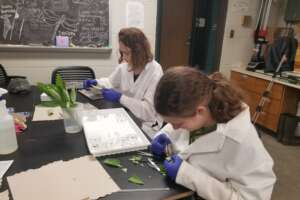Karen Oberhauser, Monarch Butterfly Fund Board of Directors and Professor Emerita of UW-Madison Department of Entomology
Every year, World Wildlife Fund (WWF)-Mexico, in collaboration with the National Commission of Protected Natural Areas in Mexico and the WWF-TELMEX Telcel Foundation Alliance, monitors the area occupied by monarch butterflies that have migrated from northern breeding grounds in the U.S. and Canada to overwintering grounds in the mountains of central Mexico (see figure). Their findings for the 2023-2024 winter season, released February 7, document a 59% decline from last year: 0.90 hectares (ha) compared to 2.21 ha last year (a hectare is about 2.5 acres). This value is used to estimate the size of the eastern North American monarch population from year to year. While the number of monarchs in a hectare varies from year to year and is difficult to estimate, our best estimate is that the average is about 21 million.

Insect populations are notorious for their annual fluctuations, but this value is concerning. It is the second lowest ever reported; only the winter of 2013-2014 was lower (0.67 ha). In 31 years of measurements, only six years have declined over 55% from one season to the next and a drop this dramatic has never before occurred after a year as low as last year’s 2.21 ha. While monarchs did rebound after the low of 2013, numbers this low leave the population more vulnerable to catastrophic events, like a winter storm in the next month before monarchs leave their wintering grounds, or weather conditions that lead to low reproductive success in next spring or summer.
What caused this decline?
While detailed analyses will take time, most scientists concur that the main factors that currently drive monarch numbers from one year to the next are weather related. And weather conditions over a large area can affect monarchs. They’ll migrate north out of central Mexico in mid-March, reproduce in northern Mexico and the southeastern quarter of the U.S. A new generation will move into their summer breeding grounds in the northeastern quarter of the U.S., followed by two new generations before the final generation of the year moves back to Mexico beginning in late August.
Hot and dry (or cold and wet) conditions during the spring as monarchs move through northern Mexico and the southern U.S. curtail spring reproduction, and the same is true in their more northern summer breeding grounds. Additionally, the long-term drought in the south is likely to have affected the success of their fall migration by decreasing nectar availability. There are concerning indications that the conditions that are bad for monarchs are becoming more common due to human-induced climate change. Additionally, there is strong evidence that a two decade decline from the mid-1990’s through about 2005 was driven by loss of breeding habitat. The amount of available habitat sets a ceiling for how many monarchs can be produced in a “good” year, and that ceiling is lower than it was in the past. Restoration efforts appear to be just keeping pace with ongoing habitat loss, so there has been little change in habitat availability over the past 20 or so years.
What can you do to support monarchs?
If you can, create milkweed and nectar-plant rich habitat to raise the ceiling for monarch numbers. Second, help us understand the monarch population by joining a monarch citizen science project, like the Monarch Larva Monitoring Project or Journey North. Third, support organizations working to preserve monarch habitat. Fourth, spread the word; tell your family and friends how they too can help monarchs. And finally, do what you can to mitigate climate change by working to decrease your own and society’s production of harmful greenhouse gas emissions. Making the world better for monarchs will make it better for thousands of other organisms, including people.
The press release from WWF can be found here (in spanish). For more information on how these estimates are obtained each year, and for the link to this year's study, visit our Population Status page.
Sobering news that prompts all of us to re-double our efforts to protect the monarch’s habitat in North America.




